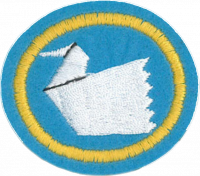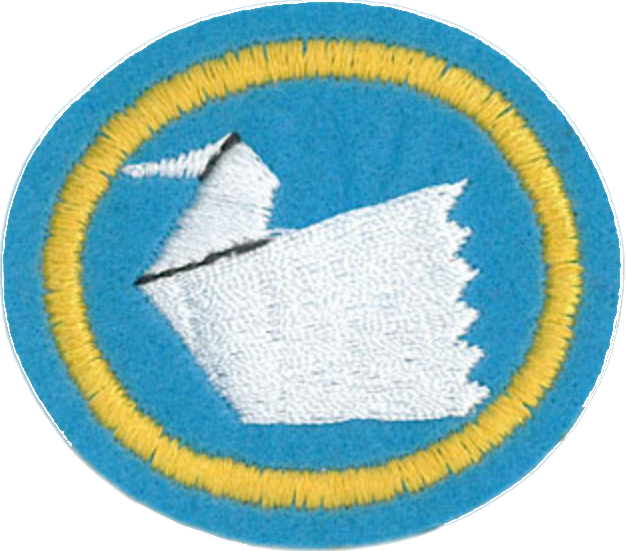Difference between revisions of "AY Honors/Origami/Answer Key/es"
From Pathfinder Wiki
(Created page with "==4. Demostrar cómo se doblan las siguientes bases:==") |
(Updating to match new version of source page) |
||
| (30 intermediate revisions by 3 users not shown) | |||
| Line 1: | Line 1: | ||
| − | < | + | {{HonorSubpage}} |
| − | + | <section begin="Body" /> | |
| + | {{ansreq|page={{#titleparts:{{PAGENAME}}|2|1}}|num=1}} | ||
<noinclude></noinclude> | <noinclude></noinclude> | ||
| − | + | <!-- 1. ¿Qué es el Origami? ¿De dónde proviene? ¿Cómo es utilizado? ¿Cómo se desarrolló? --> | |
| − | |||
| − | |||
| − | |||
| − | |||
| − | |||
| − | |||
| − | |||
| − | |||
| − | |||
| − | |||
| − | |||
{{clear}} | {{clear}} | ||
| Line 21: | Line 11: | ||
{{clear}} | {{clear}} | ||
| − | ==2. Identificar los símbolos para los siguientes términos: | + | <noinclude></noinclude> |
| + | {{CloseReq}} <!-- 1 --> | ||
| + | {{ansreq|page={{#titleparts:{{PAGENAME}}|2|1}}|num=2}} | ||
| + | <noinclude></noinclude> | ||
| + | <!-- 2. Identificar los símbolos para los siguientes términos: --> | ||
{{clear}} | {{clear}} | ||
| − | == | + | <noinclude></noinclude> |
| + | {{ansreq|page={{#titleparts:{{PAGENAME}}|2|1}}|num=2a}} <!--T:8--> | ||
| + | <noinclude></noinclude> | ||
| − | == | + | <noinclude></noinclude> |
| + | {{CloseReq}} <!-- 2a --> | ||
| + | {{ansreq|page={{#titleparts:{{PAGENAME}}|2|1}}|num=2b}} <!--T:9--> | ||
| + | <noinclude></noinclude> | ||
| − | == | + | <noinclude></noinclude> |
| + | {{CloseReq}} <!-- 2b --> | ||
| + | {{ansreq|page={{#titleparts:{{PAGENAME}}|2|1}}|num=2c}} <!--T:10--> | ||
| + | <noinclude></noinclude> | ||
{{clear}} | {{clear}} | ||
| − | == | + | <noinclude></noinclude> |
| + | {{CloseReq}} <!-- 2c --> | ||
| + | {{ansreq|page={{#titleparts:{{PAGENAME}}|2|1}}|num=2d}} <!--T:12--> | ||
| + | <noinclude></noinclude> | ||
| − | == | + | <noinclude></noinclude> |
| + | {{CloseReq}} <!-- 2d --> | ||
| + | {{ansreq|page={{#titleparts:{{PAGENAME}}|2|1}}|num=2e}} <!--T:13--> | ||
| + | <noinclude></noinclude> | ||
| − | == | + | <noinclude></noinclude> |
| + | {{CloseReq}} <!-- 2e --> | ||
| + | {{ansreq|page={{#titleparts:{{PAGENAME}}|2|1}}|num=2f}} <!--T:14--> | ||
| + | <noinclude></noinclude> | ||
| − | == | + | <noinclude></noinclude> |
| + | {{CloseReq}} <!-- 2f --> | ||
| + | {{ansreq|page={{#titleparts:{{PAGENAME}}|2|1}}|num=2g}} <!--T:15--> | ||
| + | <noinclude></noinclude> | ||
| − | == | + | <noinclude></noinclude> |
| + | {{CloseReq}} <!-- 2g --> | ||
| + | {{ansreq|page={{#titleparts:{{PAGENAME}}|2|1}}|num=2h}} <!--T:16--> | ||
| + | <noinclude></noinclude> | ||
| − | == | + | <noinclude></noinclude> |
| + | {{CloseReq}} <!-- 2h --> | ||
| + | {{ansreq|page={{#titleparts:{{PAGENAME}}|2|1}}|num=2i}} <!--T:17--> | ||
| + | <noinclude></noinclude> | ||
| − | == | + | <noinclude></noinclude> |
| + | {{CloseReq}} <!-- 2i --> | ||
| + | {{ansreq|page={{#titleparts:{{PAGENAME}}|2|1}}|num=2j}} <!--T:18--> | ||
| + | <noinclude></noinclude> | ||
{{clear}} | {{clear}} | ||
| − | == | + | <noinclude></noinclude> |
| + | {{CloseReq}} <!-- 2j --> | ||
| + | {{ansreq|page={{#titleparts:{{PAGENAME}}|2|1}}|num=2k}} <!--T:20--> | ||
| + | <noinclude></noinclude> | ||
| − | ==3. Demostrar cómo se hacen los siguientes dobleces: | + | <noinclude></noinclude> |
| + | {{CloseReq}} <!-- 2k --> | ||
| + | {{CloseReq}} <!-- 2 --> | ||
| + | {{ansreq|page={{#titleparts:{{PAGENAME}}|2|1}}|num=3}} | ||
| + | <noinclude></noinclude> | ||
| + | <!-- 3. Demostrar cómo se hacen los siguientes dobleces: --> | ||
| − | == | + | <noinclude></noinclude> |
| + | {{ansreq|page={{#titleparts:{{PAGENAME}}|2|1}}|num=3a}} <!--T:22--> | ||
| + | <noinclude></noinclude> | ||
{{clear}} | {{clear}} | ||
| − | == | + | <noinclude></noinclude> |
| + | {{CloseReq}} <!-- 3a --> | ||
| + | {{ansreq|page={{#titleparts:{{PAGENAME}}|2|1}}|num=3b}} <!--T:24--> | ||
| + | <noinclude></noinclude> | ||
| − | == | + | <noinclude></noinclude> |
| + | {{CloseReq}} <!-- 3b --> | ||
| + | {{ansreq|page={{#titleparts:{{PAGENAME}}|2|1}}|num=3c}} <!--T:25--> | ||
| + | <noinclude></noinclude> | ||
| − | == | + | <noinclude></noinclude> |
| + | {{CloseReq}} <!-- 3c --> | ||
| + | {{ansreq|page={{#titleparts:{{PAGENAME}}|2|1}}|num=3d}} <!--T:26--> | ||
| + | <noinclude></noinclude> | ||
| − | == | + | <noinclude></noinclude> |
| + | {{CloseReq}} <!-- 3d --> | ||
| + | {{ansreq|page={{#titleparts:{{PAGENAME}}|2|1}}|num=3e}} <!--T:27--> | ||
| + | <noinclude></noinclude> | ||
| − | == | + | <noinclude></noinclude> |
| + | {{CloseReq}} <!-- 3e --> | ||
| + | {{ansreq|page={{#titleparts:{{PAGENAME}}|2|1}}|num=3f}} <!--T:28--> | ||
| + | <noinclude></noinclude> | ||
| − | ==4. Demostrar cómo se doblan las siguientes bases: | + | <noinclude></noinclude> |
| + | {{CloseReq}} <!-- 3f --> | ||
| + | {{CloseReq}} <!-- 3 --> | ||
| + | {{ansreq|page={{#titleparts:{{PAGENAME}}|2|1}}|num=4}} | ||
| + | <noinclude></noinclude> | ||
| + | <!-- 4. Demostrar cómo se doblan las siguientes bases: --> | ||
| − | == | + | <noinclude></noinclude> |
| − | + | {{ansreq|page={{#titleparts:{{PAGENAME}}|2|1}}|num=4a}} <!--T:30--> | |
| + | <noinclude></noinclude> | ||
| − | + | <noinclude></noinclude> | |
| − | + | {{CloseReq}} <!-- 4a --> | |
| − | < | + | {{ansreq|page={{#titleparts:{{PAGENAME}}|2|1}}|num=4b}} <!--T:31--> |
| − | + | <noinclude></noinclude> | |
| − | </ | ||
| − | == | + | <noinclude></noinclude> |
| − | + | {{CloseReq}} <!-- 4b --> | |
| + | {{ansreq|page={{#titleparts:{{PAGENAME}}|2|1}}|num=4c}} <!--T:32--> | ||
| + | <noinclude></noinclude> | ||
| − | + | {{clear}} | |
| − | |||
| − | |||
{{clear}} | {{clear}} | ||
| Line 91: | Line 144: | ||
{{clear}} | {{clear}} | ||
| − | + | <noinclude></noinclude> | |
| − | {{ | + | {{CloseReq}} <!-- 4c --> |
| + | {{CloseReq}} <!-- 4 --> | ||
| + | {{ansreq|page={{#titleparts:{{PAGENAME}}|2|1}}|num=5}} | ||
| + | <noinclude></noinclude> | ||
| + | <!-- 5. Hacer tres de los siguientes modelos: --> | ||
| − | == | + | <noinclude></noinclude> |
| − | + | {{ansreq|page={{#titleparts:{{PAGENAME}}|2|1}}|num=5a}} <!--T:38--> | |
| + | <noinclude></noinclude> | ||
| − | == | + | <noinclude></noinclude> |
| − | + | {{CloseReq}} <!-- 5a --> | |
| + | {{ansreq|page={{#titleparts:{{PAGENAME}}|2|1}}|num=5b}} <!--T:39--> | ||
| + | <noinclude></noinclude> | ||
| − | == | + | <noinclude></noinclude> |
| − | + | {{CloseReq}} <!-- 5b --> | |
| + | {{ansreq|page={{#titleparts:{{PAGENAME}}|2|1}}|num=5c}} <!--T:40--> | ||
| + | <noinclude></noinclude> | ||
| − | == | + | <noinclude></noinclude> |
| − | + | {{CloseReq}} <!-- 5c --> | |
| + | {{ansreq|page={{#titleparts:{{PAGENAME}}|2|1}}|num=5d}} <!--T:41--> | ||
| + | <noinclude></noinclude> | ||
| − | == | + | <noinclude></noinclude> |
| + | {{CloseReq}} <!-- 5d --> | ||
| + | {{ansreq|page={{#titleparts:{{PAGENAME}}|2|1}}|num=5e}} <!--T:42--> | ||
| + | <noinclude></noinclude> | ||
| − | + | {{clear}} | |
| − | + | <noinclude></noinclude> | |
| − | + | {{CloseReq}} <!-- 5e --> | |
| − | + | {{CloseReq}} <!-- 5 --> | |
| + | {{ansreq|page={{#titleparts:{{PAGENAME}}|2|1}}|num=6}} | ||
| + | <noinclude></noinclude> | ||
| + | <!-- 6. Elegir tres de los siguientes modelos para doblar o seleccionar modelos similares de libros de origami: --> | ||
| − | == | + | <noinclude></noinclude> |
| − | + | {{ansreq|page={{#titleparts:{{PAGENAME}}|2|1}}|num=6a}} <!--T:45--> | |
| − | + | <noinclude></noinclude> | |
| − | |||
| − | == | + | <noinclude></noinclude> |
| − | + | {{CloseReq}} <!-- 6a --> | |
| + | {{ansreq|page={{#titleparts:{{PAGENAME}}|2|1}}|num=6b}} <!--T:46--> | ||
| + | <noinclude></noinclude> | ||
| − | = | + | <noinclude></noinclude> |
| − | + | {{CloseReq}} <!-- 6b --> | |
| − | + | {{ansreq|page={{#titleparts:{{PAGENAME}}|2|1}}|num=6c}} <!--T:47--> | |
| − | + | <noinclude></noinclude> | |
| − | = | + | <noinclude></noinclude> |
| − | + | {{CloseReq}} <!-- 6c --> | |
| − | + | {{ansreq|page={{#titleparts:{{PAGENAME}}|2|1}}|num=6d}} <!--T:48--> | |
| − | + | <noinclude></noinclude> | |
| − | == | + | <noinclude></noinclude> |
| − | + | {{CloseReq}} <!-- 6d --> | |
| + | {{ansreq|page={{#titleparts:{{PAGENAME}}|2|1}}|num=6e}} <!--T:49--> | ||
| + | <noinclude></noinclude> | ||
| − | = | + | <noinclude></noinclude> |
| − | + | {{CloseReq}} <!-- 6e --> | |
| + | {{ansreq|page={{#titleparts:{{PAGENAME}}|2|1}}|num=6f}} <!--T:50--> | ||
| + | <noinclude></noinclude> | ||
| − | + | <noinclude></noinclude> | |
| − | + | {{CloseReq}} <!-- 6f --> | |
| − | + | {{ansreq|page={{#titleparts:{{PAGENAME}}|2|1}}|num=6g}} <!--T:51--> | |
| − | + | <noinclude></noinclude> | |
| − | |||
| − | ==7 | + | <noinclude></noinclude> |
| − | + | {{CloseReq}} <!-- 6g --> | |
| + | {{CloseReq}} <!-- 6 --> | ||
| + | {{ansreq|page={{#titleparts:{{PAGENAME}}|2|1}}|num=7}} | ||
| + | <noinclude></noinclude> | ||
| + | <!-- 7. Doblar un modelo de memoria de los requisitos 5 o 6. --> | ||
| − | + | <noinclude></noinclude> | |
| − | + | {{CloseReq}} <!-- 7 --> | |
| − | + | {{ansreq|page={{#titleparts:{{PAGENAME}}|2|1}}|num=8}} | |
| − | + | <noinclude></noinclude> | |
| − | + | <!-- 8. Ilustrar una historia de la Biblia usando varios modelos de origami. --> | |
| − | |||
| − | |||
| − | {{ | + | <noinclude></noinclude> |
| + | {{CloseReq}} <!-- 8 --> | ||
| + | <noinclude></noinclude> | ||
{{clear}} | {{clear}} | ||
| Line 163: | Line 241: | ||
{{clear}} | {{clear}} | ||
| − | ==Referencias== | + | ==Referencias==</noinclude> |
| − | + | {{CloseHonorPage}} | |
| − | |||
| − | |||
Latest revision as of 16:18, 14 July 2022
1
¿Qué es el origami? ¿De dónde proviene? ¿Cómo es utilizado? ¿Cómo se desarrolló?
2
Identificar los símbolos para los siguientes términos:
2a
Doblez en forma de valle
2b
Doblez en forma de montaña
2c
Cortar
2d
Doblez existente
2e
Mantener aquí
2f
Mirar este lugar
2g
En frente de
2h
Detrás de
2i
Meter en, abrir, aplicar fuerza
2j
Doblar una y otra vez
2k
Girar el modelo
3
Demostrar cómo se hacen los siguientes dobleces:
3a
Doblado hacia atrás
3b
Doblado apretado
3c
Doblado pétalo
3d
Doblado libro
3e
Doblado preliminar
3f
Doblado Blintz
4
Demostrar cómo se doblan las siguientes bases:
4a
Base para pájaros
4b
Base para bombas de agua
4c
Base para ranas
5
Hacer tres de los siguientes modelos:
5a
Casa
5b
Flor de loto
5c
Cigarra
5d
Mosca
5e
Mariposa
6
Elegir tres de los siguientes modelos para doblar o seleccionar modelos similares de libros de origami:
6a
Ranas que saltan
6b
Paloma mensajera
6c
Velero
6d
Gallina
6e
Hoja
6f
Perro caminando
6g
Pato
7
Doblar un modelo de memoria de los requisitos 5 o 6.
8
Ilustrar una historia de la Biblia usando varios modelos de origami.


